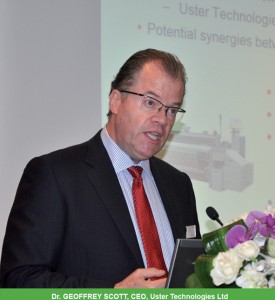 Uster Technologies Ltd. has launched a new CLASSIMAT classification system. The USTER CLASSIMAT 5 takes quality assurance to a new level, enabling a deeper understanding of defects and their causes, and finding ways to prevent them. Innovative features and capabilities can pinpoint outliers, providing consistent quality levels for both producers and users of yarns.
Uster Technologies Ltd. has launched a new CLASSIMAT classification system. The USTER CLASSIMAT 5 takes quality assurance to a new level, enabling a deeper understanding of defects and their causes, and finding ways to prevent them. Innovative features and capabilities can pinpoint outliers, providing consistent quality levels for both producers and users of yarns.
Parameters measured by the USTER CLASSIMAT have played a vital role in spinning mills and yarn trading worldwide since the instrument was first developed more than 40 years ago. The classification of yarn defects according to their size and length into 23 standard classes is used extensively to certify yarn quality, to help control spinning processes and to optimize yarn clearing at the winding stage.
In the meantime, quality demands have increased enormously. While fault classification based on the well-proven analysis of thick and thin places remains fundamental, it must now also cover critical parameters such as foreign matter, count variation, periodic faults, unevenness and hairiness. An important quality management aspect that has grown rapidly in significance is the need for consistent quality as much as absolute quality. This demands critical new tools for large-scale production, to assess extreme deviations from the quality norm, referred to as outliers.
Classifying all outliers
Addressing these requirements, USTER CLASSIMAT 5 delivers all the traditional classification standards, while broadening its scope to include outliers, which are often the root cause of claims and inconsistent yarn quality. USTER CLASSIMAT 5 for the first time detects and quantifies outliers for periodic faults, evenness, imperfections and hairiness, in addition to critical thick and thin places.
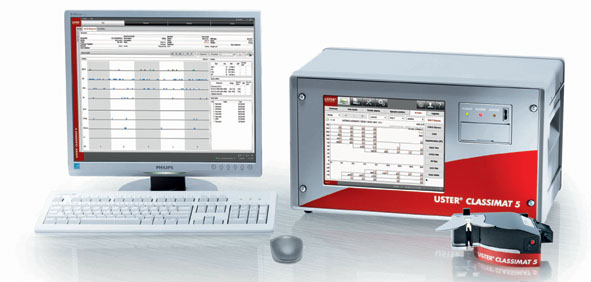 The USTER CLASSIMAT 5 is the tool of choice for those who want to understand the nature and sources of these defects and to develop preventive strategies. Especially important are its powerful foreign matter tools for assessing colored foreign fibers, vegetable matter and, for the first time, polypropylene content.
The USTER CLASSIMAT 5 is the tool of choice for those who want to understand the nature and sources of these defects and to develop preventive strategies. Especially important are its powerful foreign matter tools for assessing colored foreign fibers, vegetable matter and, for the first time, polypropylene content.
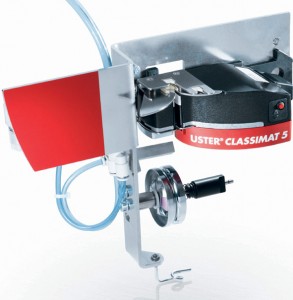 The full range of quality measurements handled by USTER CLASSIMAT 5 is complemented by powerful analytical tools. It integrates a clearing limit analysis feature, which can estimate and display the applied clearing limit for the yarn, as well as providing an index to optimize the clearing limit in each area, including foreign matter. Yarns from different lots or suppliers can now be compared, to identify the best and the next best quality levels, with detailed figures available at a click, and presented as intuitive color codings.
The full range of quality measurements handled by USTER CLASSIMAT 5 is complemented by powerful analytical tools. It integrates a clearing limit analysis feature, which can estimate and display the applied clearing limit for the yarn, as well as providing an index to optimize the clearing limit in each area, including foreign matter. Yarns from different lots or suppliers can now be compared, to identify the best and the next best quality levels, with detailed figures available at a click, and presented as intuitive color codings.
State-of-the-art technology
These customer benefits are possible, thanks to the most technically-advanced sensors and superior hardware for detection and eventual classification of all types of defects. For the first time, USTER CLASSIMAT 5 measurements are independent of the machine or test speed variations. The unique mounting module includes a special cleaning facility to prevent dirt and fluff in the measuring zone. An array of guides and a tension control also ensure highest accuracy in foreign matter classification.
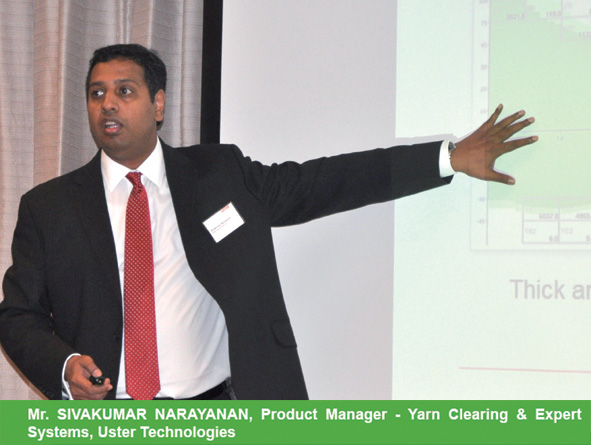 Dr. Geoffrey Scott, CEO of Uster Technologies Ltd., comments: “We are proud to offer the new generation of CLASSIMAT to the textile industry. It brings quality assurance to a new level, introducing an unrivaled range of new features and capabilities. It is not only an indispensable precision tool for both producers and users of yarns, it is also transforming the industry.”
Dr. Geoffrey Scott, CEO of Uster Technologies Ltd., comments: “We are proud to offer the new generation of CLASSIMAT to the textile industry. It brings quality assurance to a new level, introducing an unrivaled range of new features and capabilities. It is not only an indispensable precision tool for both producers and users of yarns, it is also transforming the industry.”
The unique Total Testing approach
Total Testing is a novel approach to help mills manage uncertainties and achieve predictable profits through cost and quality control. Total Testing is a unique combination of laboratory testing, process monitoring and know-how from Uster Technologies.
It has four elements:
* From fiber to fabric, incorporating quality management along the entire textile value chain.
* From sampling to continuous testing, comparing laboratory testing and in-process monitoring results to identify symptoms and causes, and develop process improvements.
* From varying to consistent quality, optimizing processes to produce yarn of consistent quality at the lowest possible cost.
* From subjective to objective quality, using USTER STATISTICS for objective and transparent product certification.
Implications for Chinese market
Chinese mills are currently facing many challenges, most of which they can control in only a limited way. To start with, cotton prices have been very volatile and remain at historically high levels. In addition, levels of contamination, stickiness and seed-coat fragments in raw cotton increased in 2011, with China among the countries with the highest level of contamination (ITMF Cotton Contamination Report).
At the same time, the cost and availability of energy continues to be an issue. On top of this, labor costs are increasing, and it is more difficult than ever to find educated staff for the textile sector, against competition from other sectors and other countries. Rising labor costs are regarded as a significant concern by 63 per cent of 557 respondents in the annual business confidence survey by the European Chamber of Commerce in China.
What is more, demand is softening, and there are some clouds on the horizon. Yarn prices in China have also slowly adjusted downwards after strong increases in the first half of 2011, and are now stabilized at a level of CNY about 2600 / kg ($1.87 / lb). These are all factors which Chinese spinning mills can influence to only a very limited extent. They are therefore forced to put the emphasis on maximizing operations within the mill, managing cost and controlling quality, and this is the starting point for Total Testing.
Taking control from the start
Cotton is the single largest cost element in yarn production. As a rule of thumb, the cost of cotton represents 50-70 per cent of the total cost of yarn. Yet influencing the price of cotton is almost impossible for the spinner. The challenge is therefore to maximize the output of every pound of cotton.
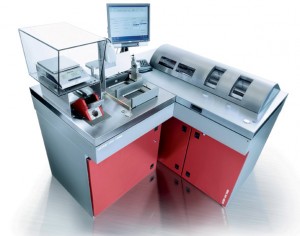 One of the most important and widely-used quality indicators for cotton is micronaire (‘fineness’ in laymen’s terms). Linked to this, one of the most feared quality problems associated with cotton fiber is ‘barré’ – unwanted stripes appearing in the finished fabric through high micronaire variation. Cotton Incorporated has conducted studies showing that a single occurrence of barré can cost as much as CNY 200,000 ($28,000) in terms of resulting off-quality product value.
One of the most important and widely-used quality indicators for cotton is micronaire (‘fineness’ in laymen’s terms). Linked to this, one of the most feared quality problems associated with cotton fiber is ‘barré’ – unwanted stripes appearing in the finished fabric through high micronaire variation. Cotton Incorporated has conducted studies showing that a single occurrence of barré can cost as much as CNY 200,000 ($28,000) in terms of resulting off-quality product value.
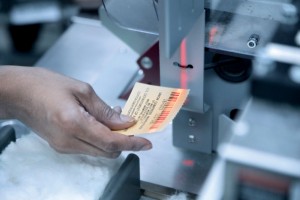 In China, mills typically buy lots consisting of 100 bales of cotton, where micronaire can vary from 3.7 to 5.1 between individual cotton bales. A recent USTER study of the situation in China found eight instances over a six-week period where micronaire varied significantly enough between laydowns to cause barré (the threshold lies at ±0.1 variance between subsequent laydowns). To address this issue and create a material mix with a constant micronaire, it is normal for mills to rely on sample testing of cotton, covering 10 per cent of the bales.
In China, mills typically buy lots consisting of 100 bales of cotton, where micronaire can vary from 3.7 to 5.1 between individual cotton bales. A recent USTER study of the situation in China found eight instances over a six-week period where micronaire varied significantly enough between laydowns to cause barré (the threshold lies at ±0.1 variance between subsequent laydowns). To address this issue and create a material mix with a constant micronaire, it is normal for mills to rely on sample testing of cotton, covering 10 per cent of the bales.
As the study shows, this is not enough and will probably produce yarn causing barré defects on a regular basis. The result will be claims – increasing cost and draining profitability for the mill.
By using the fiber testing instruments USTER HVI or USTER MF100 specifically developed for the requirements of Chinese spinners, mills can test enough samples to control the variation of micronaire in every laydown. The solution is a simple two-step: sample testing of 25 per cent of the bales of each lot to identify outliers, and 100 per cent testing of all bales within each lot containing outliers.
This solution corresponds to the second element of Total Testing – shifting from sampling to continuous testing – and demonstrates how preventing a single instance of barré-affected yarn can save a mill as much as CNY 200,000 ($28,000) in claim costs.
Total Testing – the Uster Technologies approach supporting Chinese spinners for greater success, helping them progress from uncertain results to predictable profits.
The Uster Group is the leading high-technology instrument manufacturer of products for quality measurement and certification for the textile industry. It provides testing and monitoring instruments, systems and services that allow optimization of quality through each individual stage of textile production. This includes raw textile fibers, such as cotton or wool, all staple fiber and filament yarns, as well as downstream services to the final finished fabric.